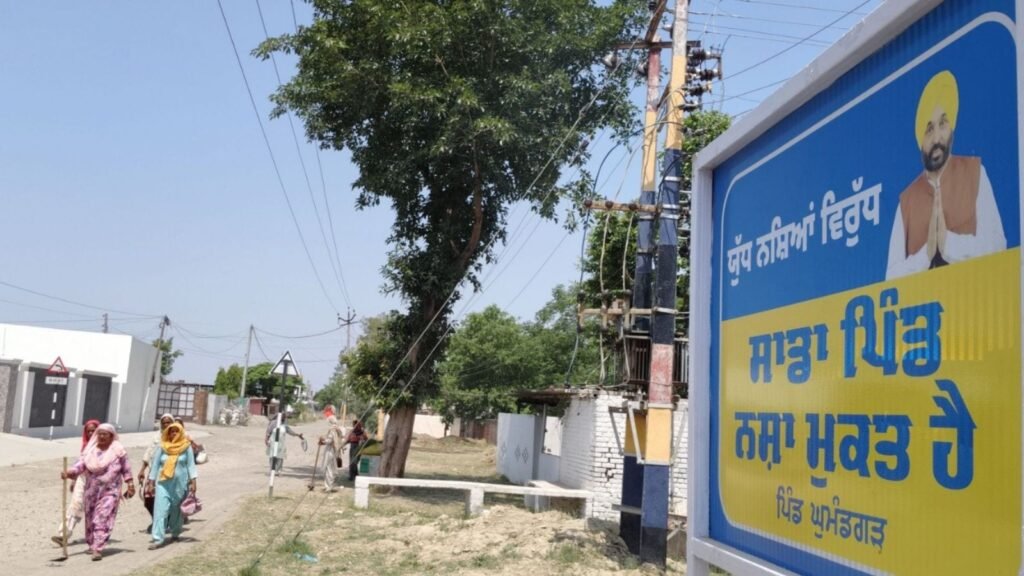The Punjabi word ghumand translates to arrogance, but for residents of Ghumandgarh, it’s pride of a different kind. While many villages across Punjab grapple with drug menace, Ghumandgarh in Fatehgarh Sahib stands out as a model of resistance, fiercely protective of its youth and community values.
“In Ghumandgarh, ghumand is a vow. We have vowed that our youth will never take to drugs. It’s a mission we’re united on,” said Palwinder Singh, sarpanch of the 1,700-strong village with 1,100 votes.
The panchayat has declared the village nasha-mukt (drug-free). Their declaration comes amid the state-wide Yudh Nasheyan Virudh (War Against Drugs), a campaign intensified by the Bhagwant Mann-led Punjab government after AAP’s defeat in the Delhi Assembly elections in February.
On March 1, the state government set up a five-member cabinet committee to monitor the crackdown, with the CM himself holding high-level meetings and directing the police to take coordinated, aggressive action. As part of the campaign, drug hotspots are being mapped, supply chains dismantled, traffickers arrested, and the properties of peddlers bulldozed. Both CM Mann and DGP Gaurav Yadav have publicly committed to curbing the menace by May 31.
In Ghumandgarh, the village’s zero-tolerance policy includes blocking outsiders with “suspicious credentials” from settling in. Youth are engaged through regular sports—cricket matches nearly every week—and cultural events such as dastar-bandi competitions. “You won’t find a single youth hooked to drugs. The number of them playing practise matches in our playground every evening is proof,” said Manpreet Singh, a resident.
The infrastructure speaks: a smart elementary and senior secondary school, a stadium with facilities for five games, an Ayushman Arogya Kendra, veterinary clinic, panchayat ghar and a cooperative society. Public announcements from the village gurdwara spread awareness and flag any suspicious activity.
Manpreet, who commutes to Kharar for work daily, said, “Outside, I see substance abuse everywhere. But coming back to my village each evening feels like returning to an oasis.”
Story continues below this ad
No police case — or even a brawl — has been reported in Ghumandgarh in 30 years, said Palwinder, adding that even during the ongoing campaign, police found zero cases of drug addiction. “That’s why we’ve been declared nasha-mukt. We’ll now apply for the Rs 1 lakh grant announced by the CM,” said Palwinder.
Owing allegiance to the ruling Aam Aadmi Party, he added, “We decide unanimously to go with the ruling party — it helps get grants.” The grant, he said, will fund a gym and parks. “We’ve also sought funds for roads that are in a bad shape.”
Navpreet Kaur, a panchayat member, said CCTV cameras have been installed across the village. “We access them from our phones. If anyone looks suspicious, the sarpanch immediately tells them to return. These attempts have reduced lately. Each panchayat member is assigned a ward to monitor.
It’s a 24×7 tirade to protect our youth,” she said. The only shortfall is in the number of sports coaches. “We’ve hired some from Fatehgarh Sahib city, but it’s not enough. We pay them from panchayat funds collected by leasing land. If more coaches come, we can produce athletes. We already have a 400m track,” Palwinder added.
Story continues below this ad
The momentum is visible in neighbouring villages too. In Harlalpur, 30 km away, a religious campaign led by woman sarpanch Harjinder Kaur Cheema encourages school children to frequent the gurdwara. “We create awareness and ask them to stay away from drugs,” said Harjinder, who performs gurbani with other women every afternoon.
Her husband, Ranjit Singh Cheema, said youths are asked to perform sewa at the gurdwara every evening to keep them occupied. “There is a lot of fear of the law now. We get to see our SHO every now and then. IG HS Bhullar and SSP Shubham Aggarwal have also visited us. Peddlers are afraid and drugs are not being sold now,” he said, adding that 50 youths from the village have migrated abroad.
Yet, the campaign is not without reminders of its limits. Near Bhajan Singh’s house, a pall of silence hangs. His nephew has taken to chitta. “He has been in a bad shape. I took him to Fatehgarh Sahib hospital. He’s on pills now. I don’t know what will happen,” he said. Another youth, now deprived of his fix, collapsed from withdrawal and had to be hospitalised. “He’s also on medication,” said Bhajan.
In Unchha Jatana village near Khanna, lambardar Bhupinder Singh said police had directed locals not to shelter peddlers fleeing raids. “They’re on the run now. We guard the village round the clock.”
Story continues below this ad
Sarpanch Pawanpreet Singh said village heads are part of WhatsApp groups with local MLAs and DSPs. “Surveys are conducted daily. We’ve been told to report addicts immediately or face questioning.
So we stay alert. We can say we are chitta-mukt but not nasha-mukt yet. Some of our elderly are still on bhukki and opium. The drive is ongoing, the police are vigilant, and panchayats are on their toes. We may not eliminate drugs completely, but if we continue this level of vigilance, we can save our future generations,” he said.
AAP has claimed that in its three-year tenure, 6,500 major drug traffickers have been arrested, over 30,000 NDPS cases registered, 10,000 police personnel involved in trafficking transferred, and 100 police officers arrested. The government has also exhorted panchayats to declare themselves drug-free to claim the Rs 1 lakh reward.
However, Amrik Singh, a resident of Unchha Jatana, echoed a deeper concern: “The bulldozing of properties has instilled huge fear. That has helped. But the real mission will be to employ our youth. Many with MA degrees are earning Rs 12,000 to Rs 15,000 per month. They didn’t study this much to earn this. That frustration can become dangerous.”
Story continues below this ad
As May 31 approaches, the date by which the state government has vowed to make visible gains, villages like Ghumandgarh and Harlalpur are showing that community ownership—when backed by state action—can lay the foundation for lasting change. But the challenge, say many, lies beyond enforcement. It’s in the promise of opportunity.




